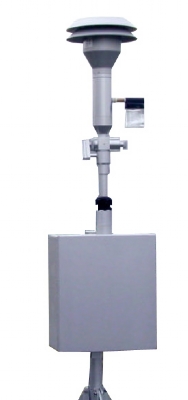
Cách phổ biến nhất để đo chất lượng không khí, liên quan đến các hạt PM 10 và PM 2.5 , là sử dụng cái gọi là Máy theo dõi suy giảm Beta , hay còn gọi là BAM (xem hình bên phải). Đó là những thiết bị chuyên nghiệp và cũng là thiết bị chính thức duy nhất được sử dụng để giám sát chất lượng không khí ở Trung Quốc, Mỹ và hầu hết trên thế giới. Nhà sản xuất nổi tiếng nhất là công ty có trụ sở tại Mỹ có tên Met-One .
Nguyên lý hoạt động của BAM khá đơn giản: Nó đo sự giảm số lượng hạt beta (electron) truyền qua một lớp vật chất hạt (PM) mỏng. Khi độ dày của lớp PM tăng lên, số lượng hạt beta có thể đi qua càng thấp.

Vấn đề duy nhất với loại thiết bị BAM này là chi phí ước tính lên tới 120 nghìn CNY (15 nghìn EUR). Chỉ ở Trung Quốc, có khoảng 500 trạm như vậy (khoảng 10 trạm cho mỗi thành phố), tuy nhiên, điều này là chưa đủ vì vẫn còn nhiều thành phố không có chỉ số PM 2.5 . Ở Thái Lan, có 21 trạm tự động (tức là đọc theo giờ), nhưng không trạm nào cung cấp dữ liệu PM 2.5 . Và ở Việt Nam chỉ có 3 trạm cho cả nước.
Vì vậy, trong khi chờ đợi tất cả các chính phủ trên thế giới đầu tư vào Máy theo dõi suy giảm Beta hoàn toàn mới, liệu có thể làm được gì không? Thì câu trả lời là có ! Trên thực tế, có những thiết bị tương đối phải chăng có thể được sử dụng để đo Chất lượng không khí dựa trên PM 10 và PM 2.5 . Nổi tiếng nhất là máy đếm hạt không khí Dylos:
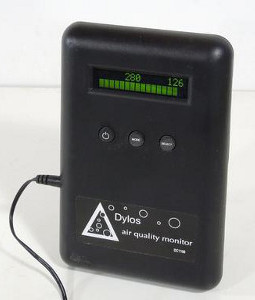
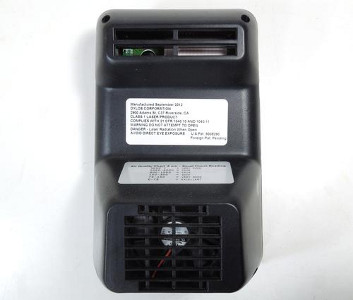
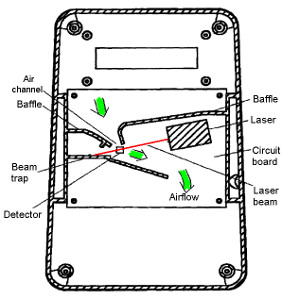
Nếu bạn muốn biết bộ đếm Hạt không khí Dylos hoạt động như thế nào, vui lòng tham khảo công trình kỹ thuật đảo ngược tuyệt vời của Matthias từ woodgears.ca hoặc đơn giản là từ trang web của Dylos ( www.dylosproducts.com/ ). Bạn cũng có thể tham khảo tài liệu nghiên cứu Một công cụ chi phí thấp để phân tích hạt môi trường dựa trên tán xạ quang học để hiểu lý thuyết đằng sau phép đo.
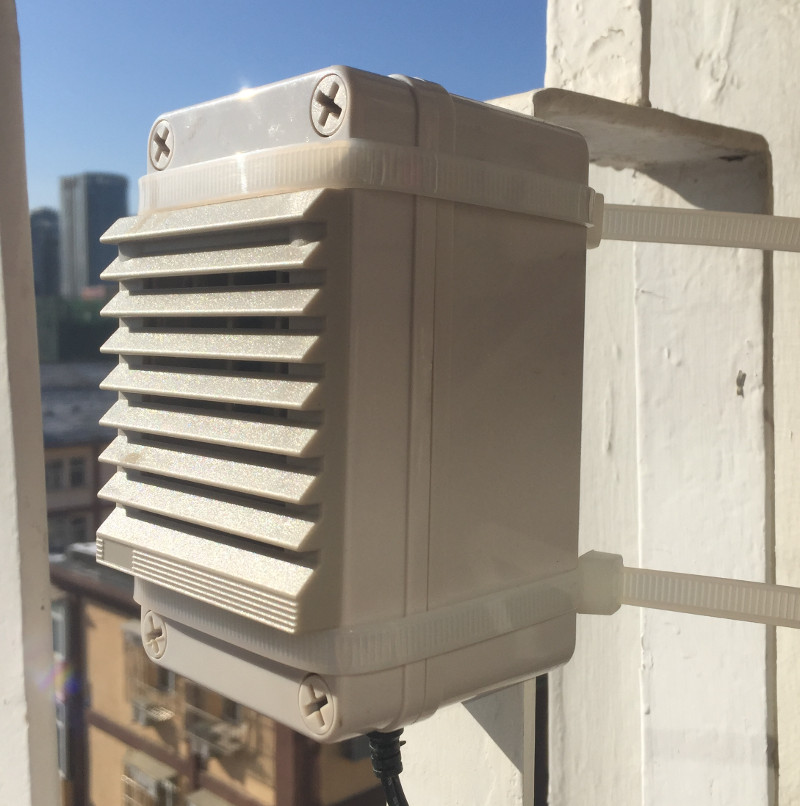
Lưu ý: bài viết này được viết vào năm 2013. Mặc dù màn hình Dylos vẫn là một sản phẩm tốt nhưng ngày nay có nhiều sản phẩm giám sát tốt hơn và giá cả phải chăng hơn nhiều, vì vậy chúng tôi khuyên bạn không nên mua sản phẩm Dylos nữa.
Ví dụ: bạn có thể kiểm tra dòng sản phẩm trạm giám sát chất lượng không khí GAIA từ ES Labs.
--
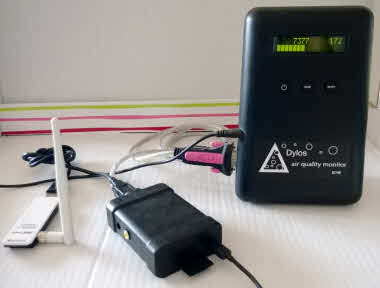
Để chứng minh quan điểm rằng thiết bị Dylos như vậy có thể được sử dụng như một giải pháp tạm thời để đo Chất lượng không khí, chúng tôi đã thiết lập một thử nghiệm nhỏ trong phòng thí nghiệm của mình, dựa trên Dylos DC 1100 Pro, với giao diện PC . Dylos PC 1000 pro tương đối rẻ và có thể mua từ Amazon với giá 319 USD.
Xin lưu ý rằng bạn phải có bản pro, với phiên bản giao diện PC . Cần có phiên bản Pro để có thể đo các hạt nhỏ như PM 2.5 , vì phiên bản không chuyên nghiệp chỉ có thể phát hiện các hạt PM10 hoặc lớn hơn. Phiên bản giao diện PC là bắt buộc vì nó cung cấp giao diện Nối tiếp, cần thiết để tự động trích xuất dữ liệu từ màn hình dylos sang PC.
Nếu bạn mua thiết bị từ Trung Quốc, từ taobao hoặc jndong (jd.com), hãy cẩn thận và đảm bảo đặt mua đúng phiên bản. Phiên bản phổ biến nhất trong DC 1100 không có giao diện PC. Chỉ có một số cửa hàng trên taobao cung cấp phiên bản phù hợp này và tại thời điểm viết bài này, jd.com thậm chí còn không cung cấp phiên bản chính xác. Nếu bạn cần trợ giúp để mua thiết bị từ Trung Quốc, bạn có thể liên hệ với chúng tôi với chủ đề "Đặt hàng thiết bị Dylos" và chúng tôi sẽ giúp bạn đặt hàng.
--
Để tự động trích xuất dữ liệu để gửi đến máy chủ, Raspberry PI ($56) và cáp nối tiếp sang USB ($9) được sử dụng, tổng BOM là $375. (Bạn có thể mua tất cả tài liệu này từ Amazon bằng cách nhấp vào hình ảnh bên dưới)
 |  |  |
| Dylos DC1100 pro with PC interface | Serial to USB cable | Raspberry PI |
Tài liệu và tập lệnh để kết nối bộ đếm hạt Dylos với Raspberry PI và tự động tải dữ liệu dylos lên máy chủ dự án Chỉ số chất lượng không khí thế giới có sẵn miễn phí từ github: github.com . Nếu bạn có bất kỳ câu hỏi nào, bạn có thể liên hệ với chúng tôi với chủ đề "Thí nghiệm Dylos".
Ngoài ra, xin lưu ý rằng khi bạn thiết lập Bộ đếm hạt Dylos bên ngoài, bạn cần phải cẩn thận ở vị trí đặt nó. Lý tưởng nhất là nên đặt ở nơi không quá nhiều gió, vì gió có thể tác động đáng kể đến kết quả đo (Lý do là bộ đếm Dylos sử dụng một chiếc quạt đơn giản để lấy luồng không khí vào và lượng không khí đi vào). mỗi phút cần không đổi để có số đọc chính xác ~ Chiếc quạt đơn giản này là một trong những lý do tại sao loại vật liệu này có giá cả phải chăng so với các cảm biến MetOne BAM chuyên nghiệp).
--
Để so sánh chỉ số Dylos với chỉ số BAM, chúng tôi sử dụng dữ liệu BAM do Phòng Triển lãm Nông nghiệp Triều Dương Bắc Kinh (朝阳农展馆) cung cấp, vì trạm của chúng tôi nằm ở khu vực Sanlitun Soho.
Và đây là kết quả theo thời gian thực: Dòng màu xanh lam là kết quả đọc dylos (được cập nhật mỗi phút) và dòng màu đỏ là dữ liệu BAM (được cập nhật mỗi giờ). Biểu đồ đầu tiên so sánh chỉ số PM 10 , trong khi biểu đồ thứ hai so sánh chỉ số PM 2.5 . Ngoài ra, xin lưu ý rằng dữ liệu BAM được cung cấp trực tiếp dưới dạng µg, tức là không được chuyển đổi sang cấp AQI.

(Click on the picture to open the real time version)
Như bạn có thể thấy, độ giống nhau giữa số đọc dylos và BAM là khá cao, nhưng không phải lúc nào cũng có thể so sánh hoàn toàn. Trong phần thứ hai của bài đăng này (chúng tôi sẽ viết sau hai tháng, khi chúng tôi đã thu thập đủ dữ liệu), chúng tôi sẽ cung cấp thêm dữ liệu thống kê về các bài đọc.
Ngoài ra, nếu bạn muốn tham gia thử nghiệm này bằng cách thiết lập trạm Dylos của riêng mình, vui lòng liên hệ với chúng tôi . Chúng tôi sẽ cung cấp tất cả các tập lệnh và thiết lập chi tiết, cũng như thêm cho bạn cơ sở dữ liệu cảm biến để bạn có thể xem kết quả đọc của mình trong thời gian thực.
--
Sau bài đăng này, bạn có thể kiểm tra bài đăng mới về việc bảo trì thí nghiệm Dylos Air Particule Conter .
